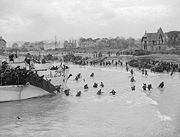The Battle of Le Mesnil-Patry was the last big operation conducted by Canadian land forces in Normandy during June 1944. The Queen's Own Rifles of Canada, supported by the 6th Canadian Armoured Regiment (1st Hussars) attempted to take the town of Le Mesnil-Patry in Normandy as part of a southwards move on the right flank of Cheux towards high ground (Hill 107) as part of the strategy of taking the city of Caen. The battle resulted in a German victory.[1]
Background[]

Canadian reserve troops disembark at 'Nan White' Beach at Bernières-sur-Mer.
On 6 June 1944, Allied forces invaded France by launching Operation Neptune, the beach landing operation of Operation Overlord. A force of several thousand ships assaulted the beaches in Normandy, supported by approximately 3,000 aircraft. The D-Day landings were generally successful but the Allied forces were unable to take Caen as planned.[2][3]
In addition to seaborne landings, the Allies also employed Airborne forces. The U.S. 101st and 82nd Airborne Divisions, as well as the British 6th Airborne Division (with an attached Canadian airborne battalion), were inserted behind the enemy lines. The British and Canadian paratroopers behind Sword Beach were to occupy strategically important bridges such as Horsa and Pegasus, as well as to take the artillery battery at Merville in order to hinder the forward progress of the German forces. They managed to establish a bridgehead north of Caen on the east bank of the Orne, that the Allied troops could use to their advantage in the battle for Caen.[4]
The battle[]
On the afternoon of Sunday 11 June, 'B' Squadron of the 1st Hussars suffered heavy losses following an abortive attack with The Queen's Own Rifles of Canada on the hamlet of Le Mesnil Patry, North-West of Caen. The attack was due to be launched in the early hours of 12 June but the information was received early on 11 June that the attack had been advanced so the Canadian forces set off at 2:30 PM.[5][6] The Canadian column advanced with B Squadron of the 1st Hussars in the lead, with men of D Company of the Queen's Own Rifles riding on the 1st Hussars's tanks.[6] Panzergrenadiers and tanks of the 12th SS Panzer Division were able to ambush the tanks of 'B' Squadron in a grain field near Le Mesnil Patry in part due to intelligence gleaned from the Hussars' radio traffic after capturing wireless codes from a destroyed Canadian tank on 9 June. After the ambush started men were flung from the tanks that they were riding as the tanks caught fire or exploded, destroying twenty.[7] The commander of the section of the Queen's Own Rifles (Major Elliot Dalton) was wounded in the leg by mortar fire.[7] The commander of the lead element of the Hussars, Lieutenant Colonel Colwell, ordered that the lead element retreat but the order was not heard. Using Panzerfausts, Panzerschrecks and anti-tank guns, the German forces were able to destroy 51 Shermans (all but two of their tanks) and inflict 61 killed or missing, 2 wounded and 11 captured on the vanguard of the 1st Hussars. All of the squadron's officers and all but three of their non-commissioned officers were lost in the fighting. The Queen's Own Rifles suffered 55 killed, 33 wounded and 11 taken prisoner during the attack.[6] An English newspaper called it the modern equivalent of the Charge of the Light Brigade.[7]
SS War Crimes[]
Following the action at Le Mesnil-Patry, the 12th SS captured 7 Canadians who were discovered wandering around no-mans land since the battle. All were reported to be tired and hungry. The men were interrogated by an officer of the 12th SS Engineering Battalion at an ad-hoc headquarters in the village of Mouen, roughly 5 miles south-east of Le Mesnil-Patry. At approximately 10.00pm the 7 men (Serjeant Thomas McLaughlin, Corporal Estel Cook, Privates John Campbell, Gerald Willet, Ernest Cranfield and Paul Bullock - all of the Queen's Own Rifles of Canada and Trooper Clayton Perry of the 1st Hussars) were led to the outskirts of the village, under armed guard. Once here, 4 of the men - Cook, Cranfield, Perry and Willet - were executed by firing squad whilst the remaining men were shot at point-blank range in the head. The SS made the local French villagers dig a mass grave and interred the men in it. The grave was discovered by elements of the British 49th (West Riding) Division when they liberated the town on 25 June. Nobody from the 12th SS was ever prosecuted for the crime.[8]
References[]
- ↑ http://www.worldoptions.com.au/fourpipers/rapid/lemsenilpatryrf2.pdf
- ↑ Ford, p. 90, 96
- ↑ Keegan, p. 143.
- ↑ Scarfe, p. 18
- ↑ http://www.normandie44lamemoire.com/versionanglaise/fichesvillesus/lemesnpatrus2.html
- ↑ 6.0 6.1 6.2 http://warchronicle.com/canadian_third_div/historiantales_wwii/victorycampaignmesnil.htm
- ↑ 7.0 7.1 7.2 Martin, pg 20
- ↑ Margolian, H, 'Conduct Unbecoming'
Bibliography[]
- Martin, Cromwell (2002). Battle Diary: From D-Day and Normandy to the Zuider Zee and VE. Quebec: Gagne Printing.
- Scarfe, Norman (2006) [1947]. Assault Division: A History of the 3rd Division from the Invasion of Normandy to the Surrender of Germany. Stroud, Gloucestershire: Spellmount Limited. ISBN 1-86227-338-3.
- Ford, Ken (2004). Sword Beach. Battle Zone Normandy. Sutton Publishing. ISBN 0-7509-3019-5.
- Keegan, John, The Times Atlas of the Second World War, Crescent Books, New York
Coordinates: 49°11′45″N 0°32′37″W / 49.19583°N 0.54361°W
The original article can be found at Battle of Le Mesnil-Patry and the edit history here.